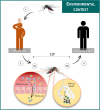The Role of Temperature in Shaping Mosquito-Borne Viruses Transmission
- PMID: 33101259
- PMCID: PMC7545027
- DOI: 10.3389/fmicb.2020.584846
The Role of Temperature in Shaping Mosquito-Borne Viruses Transmission
Abstract
Mosquito-borne diseases having the greatest impact on human health are typically prevalent in the tropical belt of the world. However, these diseases are conquering temperate regions, raising the question of the role of temperature on their dynamics and expansion. Temperature is one of the most significant abiotic factors affecting, in many ways, insect vectors and the pathogens they transmit. Here, we debate the veracity of this claim by synthesizing current knowledge on the effects of temperature on arboviruses and their vectors, as well as the outcome of their interactions.
Keywords: arboviruses; mosquitoes; temperature; vector-borne diseases; vectorial capacity.
Copyright © 2020 Bellone and Failloux.
Figures



References
-
- Adelman Z. N., Anderson M. A., Wiley M. R., Murreddu M. G., Samuel G. H., Morazzani E. M., et al. (2013). Cooler temperatures destabilize RNA interference and increase susceptibility of disease vector mosquitoes to viral infection. PLoS Negl. Trop. Dis. 7:e2239. 10.1371/journal.pntd.0002239 - DOI - PMC - PubMed
Publication types
LinkOut - more resources
Full Text Sources

